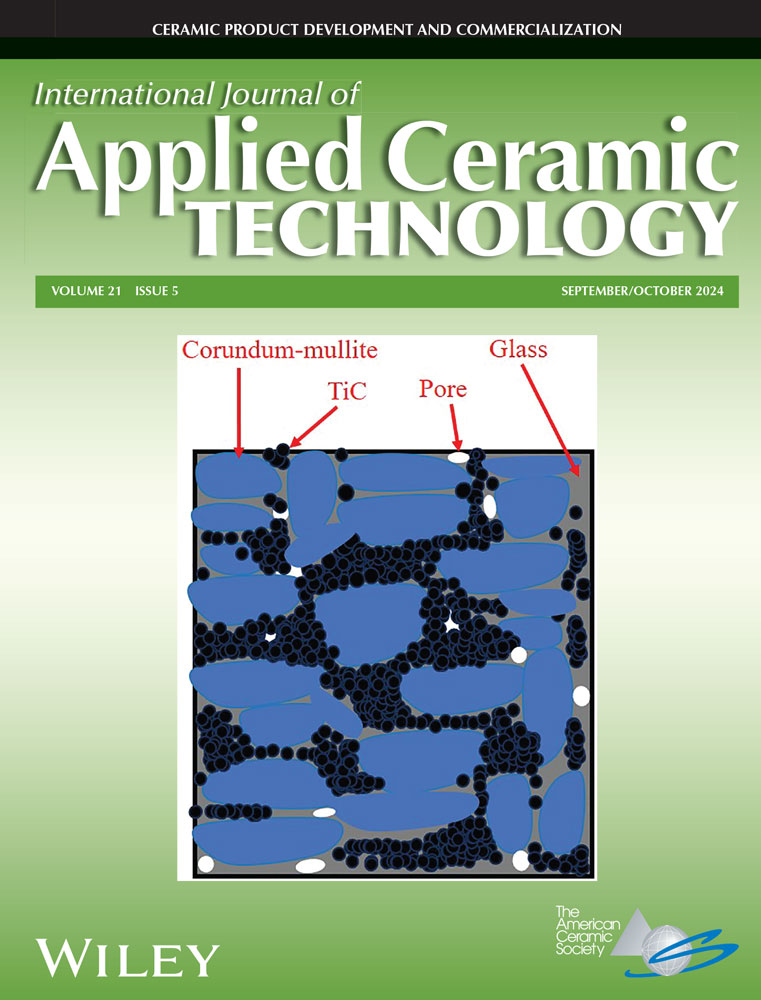静态液态铅铋共晶中 (Cr2/3Ti1/3)3AlC2 和 Ti3AlC2 的腐蚀行为
IF 2.3
4区 材料科学
Q2 MATERIALS SCIENCE, CERAMICS
引用次数: 0
摘要
研究了 (Cr2/3Ti1/3)3AlC2 和 Ti3AlC2 在 550°C 静态氧饱和液态铅铋共晶 (LBE) 中的腐蚀行为,以及 (Cr2/3Ti1/3)3AlC2 在 500°C 静态缺氧 LBE 中的腐蚀行为。在氧饱和腐蚀中,Ti3AlC2 表面生成了由 (PbTiO3 + TiO2) 组成的疏松多孔腐蚀层。相比之下,(Cr2/3Ti1/3)3AlC2 形成的 Cr2O3 保护层具有更好的耐腐蚀性。此外,(Cr2/3Ti1/3)3AlC2 在缺氧腐蚀中的溶解腐蚀在没有保护氧化膜的情况下会加剧。而表面的杂质相 TiC 也会导致基体分解,从而影响耐腐蚀性。本文章由计算机程序翻译,如有差异,请以英文原文为准。
Corrosion behavior of (Cr2/3Ti1/3)3AlC2 and Ti3AlC2 in static liquid lead–bismuth eutectic
Corrosion behavior of (Cr2/3Ti1/3)3AlC2 and Ti3AlC2 in static oxygen-saturated liquid lead–bismuth eutectic (LBE) at 550°C and (Cr2/3Ti1/3)3AlC2 in static oxygen-depleted LBE at 500°C were investigated. In oxygen-saturated corrosion, the loose and porous corrosion layer consisting of (PbTiO3 + TiO2) was generated on the surface of Ti3AlC2. In contrast, (Cr2/3Ti1/3)3AlC2 formed the protective Cr2O3 layer with better corrosion resistance. Moreover, dissolution corrosion of (Cr2/3Ti1/3)3AlC2 in oxygen-depleted corrosion was intensified without a protective oxide film. And impurity phase TiC on the surface also caused the decomposition of matrix, thus impairing corrosion resistance.
求助全文
通过发布文献求助,成功后即可免费获取论文全文。
去求助
来源期刊

International Journal of Applied Ceramic Technology
工程技术-材料科学:硅酸盐
CiteScore
3.90
自引率
9.50%
发文量
280
审稿时长
4.5 months
期刊介绍:
The International Journal of Applied Ceramic Technology publishes cutting edge applied research and development work focused on commercialization of engineered ceramics, products and processes. The publication also explores the barriers to commercialization, design and testing, environmental health issues, international standardization activities, databases, and cost models. Designed to get high quality information to end-users quickly, the peer process is led by an editorial board of experts from industry, government, and universities. Each issue focuses on a high-interest, high-impact topic plus includes a range of papers detailing applications of ceramics. Papers on all aspects of applied ceramics are welcome including those in the following areas:
Nanotechnology applications;
Ceramic Armor;
Ceramic and Technology for Energy Applications (e.g., Fuel Cells, Batteries, Solar, Thermoelectric, and HT Superconductors);
Ceramic Matrix Composites;
Functional Materials;
Thermal and Environmental Barrier Coatings;
Bioceramic Applications;
Green Manufacturing;
Ceramic Processing;
Glass Technology;
Fiber optics;
Ceramics in Environmental Applications;
Ceramics in Electronic, Photonic and Magnetic Applications;
 求助内容:
求助内容: 应助结果提醒方式:
应助结果提醒方式:


